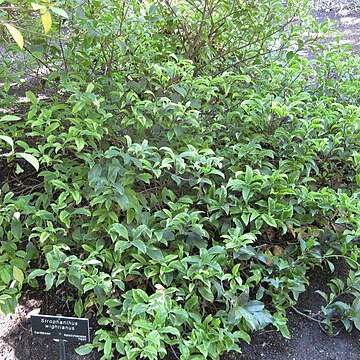Leaves petiolate opposite or rarely in some branches ternate or quaternate; petiole 1–5 mm. long, lamina dull and medium or dark green above, pale yellowish-or whitish-green beneath, ovate, narrowly elliptic, or rarely slightly obovate, 1·2–4 (on long shoots up to 6) times as long as wide, mature leaves up to 8·5 x 4·2 cm., cuneate or nearly rounded at the base, rounded, acute, or acuminate at the apex (acumen up to 8 mm. long), slightly revolute at the margin and there often reddish beneath, thinly coriaceous, glabrous or sparsely puberulous, especially on the midrib and near the margins, with 3–8(10) pairs of secondary veins; tertiary venation sometimes conspicuous beneath.
Corolla tube (13·5)17–38 mm. long and widening gradually at 1/5–2/5 of its length into a cyathiform upper part, at the mouth (11)15–27(–37) mm. wide, puberulous outside near the base, minutely pubescent or puberulous inside; corona lobes narrowly triangular, 5–23 x 1·5–5 mm., minutely papillose or puberulous; corolla lobes spreading or recurved, ovate, (10)14–38(48) x (7·5)10-24(29) mm., acute, minutely puberulous inside.
Follicles divergent at an angle of 160-240°, long-tapering towards a narrow apex and ending in an obtuse point, or rarely in a small knob, with the extreme apex sometimes curved inwards, 10·5–33·5 cm. long and 1–2·5 cm. in diam.; exocarp dark brown or purple-brown, thick and hard, glabrous, densely lenticellate.
Sepals erect or with the upper half recurved, subequal, ovate or narrowly ovate, 5–19 x 2–5·5(7) mm., acute, puberulous near the base or less often glabrous or puberulous all over.
Inflorescence 1–2(5)-flowered, sessile or pedunculate, glabrous or puberulous; pedicels 3–9(17) mm. long; bracts linear or narrowly ovate, subscarious.
Stamens included for 2–12 mm.; filaments straight or nearly so, 3–5·5 mm. long; anthers 5–8·2 x 1·2–1·9(2·5) mm., glabrous; acumen 0·2–1·7 mm. long.
Seeds with grain 8·5–19·5 x 2·5–4 x 1 mm., densely pubescent; rostrum glabrous for 17–54 mm., and bearing a coma for 22–55 mm., coma 32–95 mm. long.
Ovary 0·9–2·5 x 1·4–2·9 mm., glabrous; style 8–14·5 mm., long; clavuncula (1·3)2–3·1 x 1·5–2·3 mm.; stigma minute.
Sarmentose shrub or small tree, 0·60–5 m. high, or liana, up to 8 m. high, deciduous; latex clear or white.
Trunk up to 10(40) cm. in diam., dark brown or grey; branchlets minutely puberulous.
Flowers fragrant.


